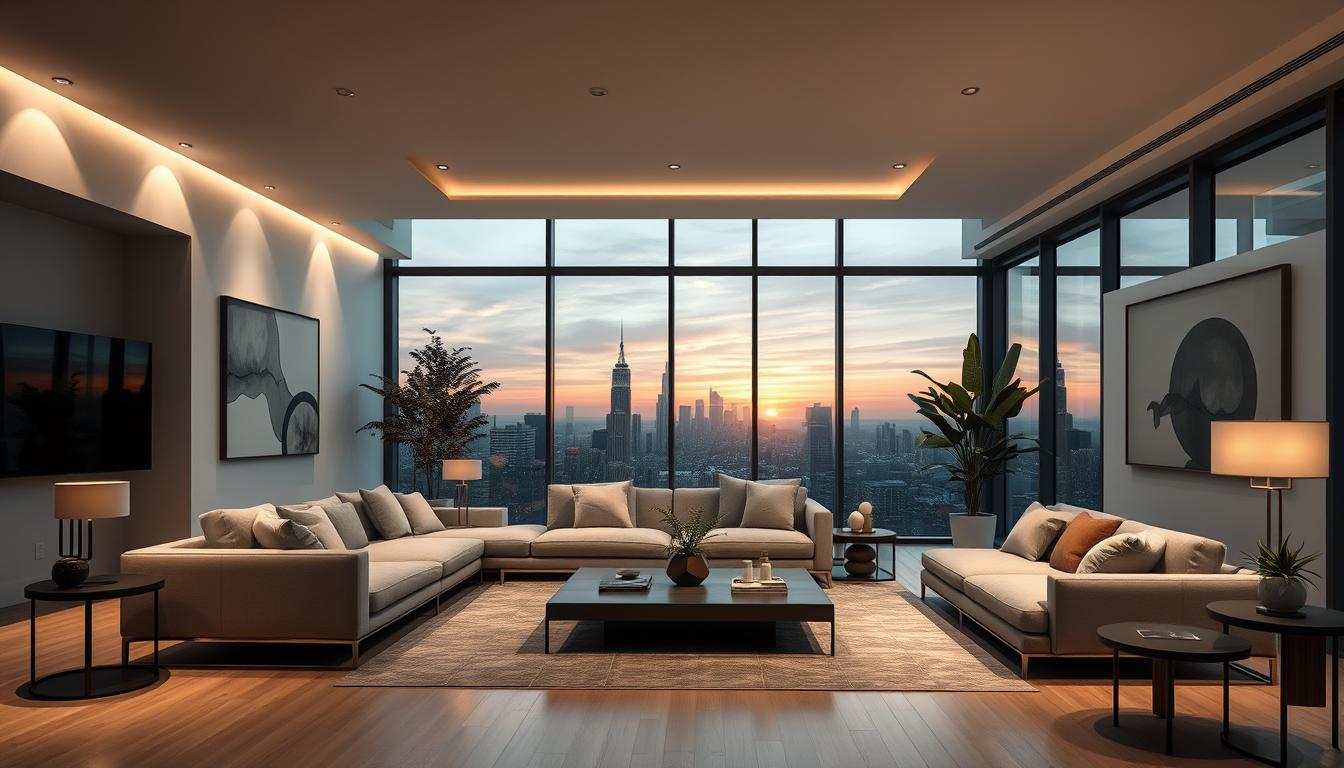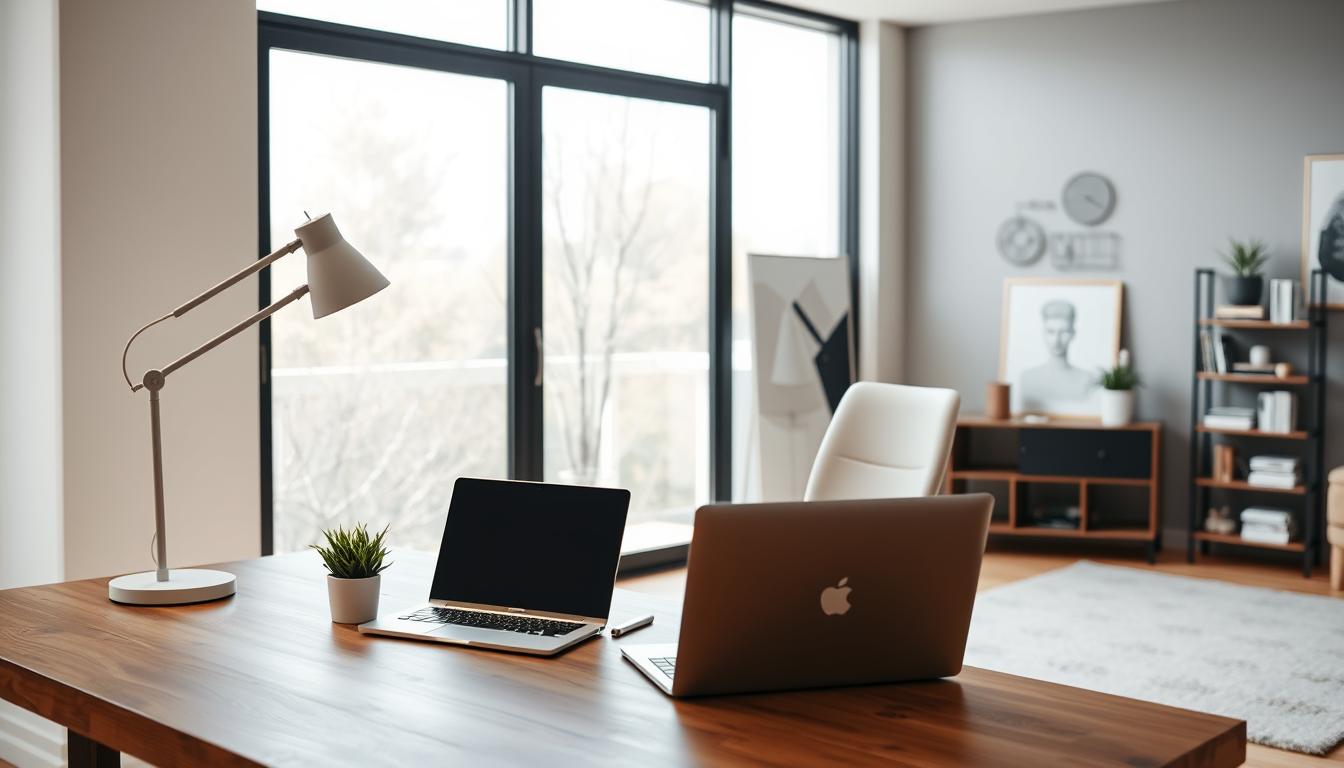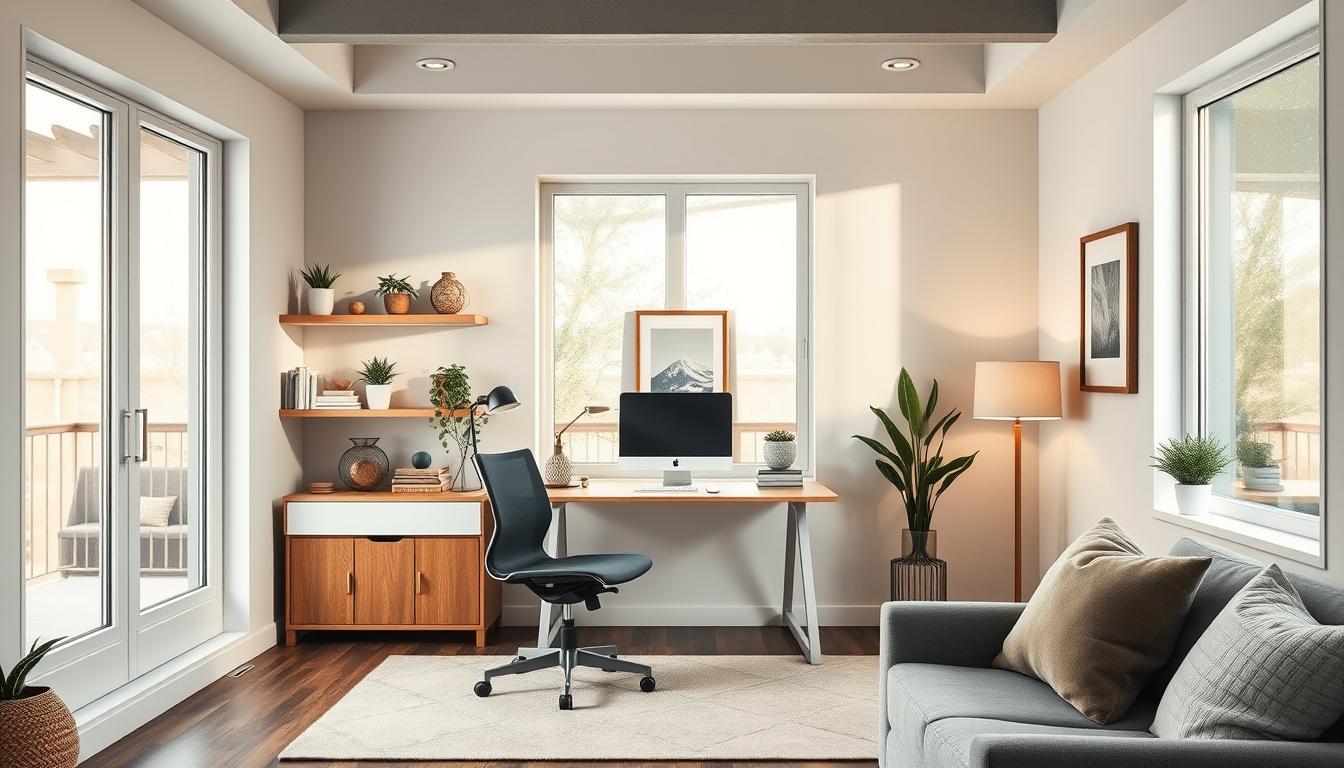Did you know that the colors in your modern home decor can change how you feel and work? The right interior design can turn your home into a space that shows off your personality and style.
Starting a new home interior project can seem overwhelming. But with our detailed guide, you’ll be ready to create a stunning and useful space. We’ll guide you through the key steps, from the basics to picking your design choices. Our guide is full of expert advice and tips to help you make smart choices.
Key Takeaways
- Understand the basics of interior design principles.
- Learn how to choose the perfect color palette for your modern home decor.
- Discover expert tips for creating a functional and beautiful living space.
- Avoid costly mistakes with our guide to finalizing your design choices.
- Get inspired with our expert advice on interior design.
Understanding the Basics of Interior Design
When designing our new home, knowing the basics of interior design is key. This knowledge helps us make choices that make our space look good and work well.
What is Interior Design?
Interior design is about making the inside of a building better. It aims to make a space healthier and more beautiful for those who use it. It’s about understanding what people need and want, then making a space that meets those needs.
Good interior design is more than just adding decorations. It’s about making a space that helps people feel good. This means thinking about lighting, color, texture, and furniture to create a space that looks and feels right.
Key Principles to Consider
There are several important principles in interior design. These include:
- Balance: Getting different elements like color, texture, and furniture to work together for a harmonious space.
- Proportion: Making sure furniture and decorations are the right size for the room and each other.
- Harmony: Choosing elements that go well together, like colors that match.
- Contrast: Using different things, like light and dark colors, to add interest.
Finding Your Design Style
Finding your design style is important. It helps create a space that shows who you are and meets your needs. Whether you like modern, traditional, or a mix, knowing what you prefer helps guide your choices.
To find your style, try these steps:
- Look at different decorating ideas online or in magazines.
- Think about what you like in the spaces you see. Is it the colors, furniture, or the whole feel?
- Think about how you live and what you need from your space. For example, if you work from home, you might need a special office area.
By understanding interior design basics, including its definition, key principles, and your style, you’re ready to create a home that’s both beautiful and practical.
Assessing Your Space
Assessing your space is key to a successful interior design project. It helps you spot challenges and opportunities. This way, you can make design choices that show your style and meet your needs.
Measuring Your Rooms
Measuring your rooms is the first step. It helps you plan the layout and ensure furniture fits. Note the dimensions of walls, doors, and windows. This info is crucial for choosing furniture and planning the layout.
Use a floor plan or sketch your rooms to better visualize the space. This helps you see how different elements will fit together.
Evaluating Natural Light
Natural light greatly affects your home’s ambiance. Check how much light each room gets and how to make the most of it. You might use sheer curtains or adjust the layout for better sunlight.
Knowing your home’s natural light helps choose the right lighting. In well-lit rooms, simpler lighting options might be best.
Understanding Traffic Flow
Traffic flow is about how people move through your home. A good design ensures a smooth, logical path. Think about the “work triangle” in kitchens and paths in living areas.
| Room | Ideal Traffic Path | Common Challenges |
|---|---|---|
| Kitchen | Clear path between sink, stove, and fridge | Cabinet placement, island size |
| Living Room | Easy navigation around furniture | Oversized furniture, poor layout |
By carefully assessing your space, you can create a home that’s both beautiful and functional. You’ll draw inspiration from home renovation inspiration and luxury home interiors.
Setting a Budget for Your Design Project
Creating a budget for your design project is key. It helps you choose stylish home furnishings and interior design trends wisely. This way, you can meet your goals without overspending.
Determining Your Priorities
Start by figuring out what matters most to you. Is it the quality of furniture, the latest interior design trends, or sustainable materials? Knowing your priorities helps you plan your budget better.
Make a list of what you must have versus what you’d like. This helps you decide where to spend your money. For example, if a special piece of furniture is a must, you might spend more on it. Then, choose more affordable options for other parts of your project.
Allocating Funds Wisely
After setting your priorities, it’s time to decide how to spend your money. Allocate 30% to 40% for key items like furniture and lighting. Use the rest for decor, textiles, and accessories.
Don’t forget to include a contingency fund in your budget. It’s for unexpected costs. This keeps your project on track and avoids financial stress.
- Research and compare prices to find the best value for your money.
- Consider shopping during sales or using coupons for non-essential items.
- Invest in quality over quantity, for items you’ll use often.
Choosing a Color Palette
The right color palette can turn your living space into a cozy and stylish haven. When designing your new home, picking a color scheme is key. It’s a decision that greatly impacts your space.
Importance of Color in Interior Design
Color greatly affects your home’s feel and look. Different colors can make you feel different emotions. For example, calming colors like blue and green can make a room feel peaceful. On the other hand, vibrant colors like red and orange can make a room lively.
When picking home decor accessories, make sure they match your color palette. This keeps your home looking unified.
Popular Color Trends
Today, popular color palettes include:
- Neutral tones with bold accents
- Monochromatic schemes for a cohesive look
- Earth tones that bring warmth and coziness
These trends can inspire you, but choose a palette that you love and fits your lifestyle.
Tips for Selecting Colors
Here are some tips for picking the perfect color palette:
- Think about the natural light in your rooms. It can change how colors look.
- Consider the mood you want in each room.
- Use a color wheel to find colors that go well together.
- Test your colors with paint samples before making a final choice.
Let’s compare different color palettes and their effects on a room’s feel:
| Color Palette | Mood/Effekt | Suitable Rooms |
|---|---|---|
| Soft Pastels | Calm, Serene | Bedrooms, Nurseries |
| Bold and Bright | Energizing, Vibrant | Living Rooms, Playrooms |
| Neutral Tones | Versatile, Timeless | Any Room |
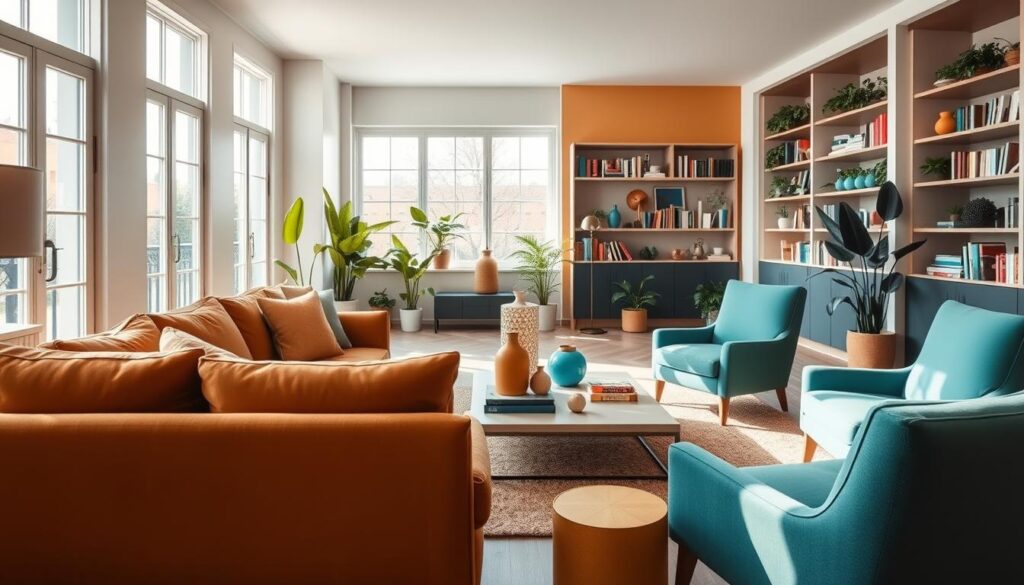
By choosing your color palette wisely, you can make a beautiful and useful living space. It will show off your personal style and improve your home’s look.
Selecting Furniture That Fits Your Style
Finding the right furniture is key to modern home decor. It affects how your home looks and works. Think about your style and your home’s theme when picking furniture.
Types of Furniture Styles
Furniture styles range from minimalist and contemporary to traditional and rustic. Knowing these styles helps you make better choices.
- Modern: Known for clean lines, simple shapes, and being very functional.
- Traditional: Features ornate details, rich colors, and classic designs.
- Rustic: Uses natural materials, earthy tones, and creates a cozy feel.
Balancing Functionality and Aesthetics
It’s important to balance how your furniture looks and works. Your furniture should be both beautiful and useful.
- Think about what each piece of furniture is for.
- Check if the furniture fits well in your space.
- Pick materials and finishes that are strong and look good.
By choosing furniture that matches your style and needs, you can make your home welcoming and beautiful.
Incorporating Textiles and Patterns
Textiles and patterns are key in modern interior design. They add depth and interest to any room. Exploring home renovation inspiration shows how fabrics, patterns, and textures can improve your space’s look.
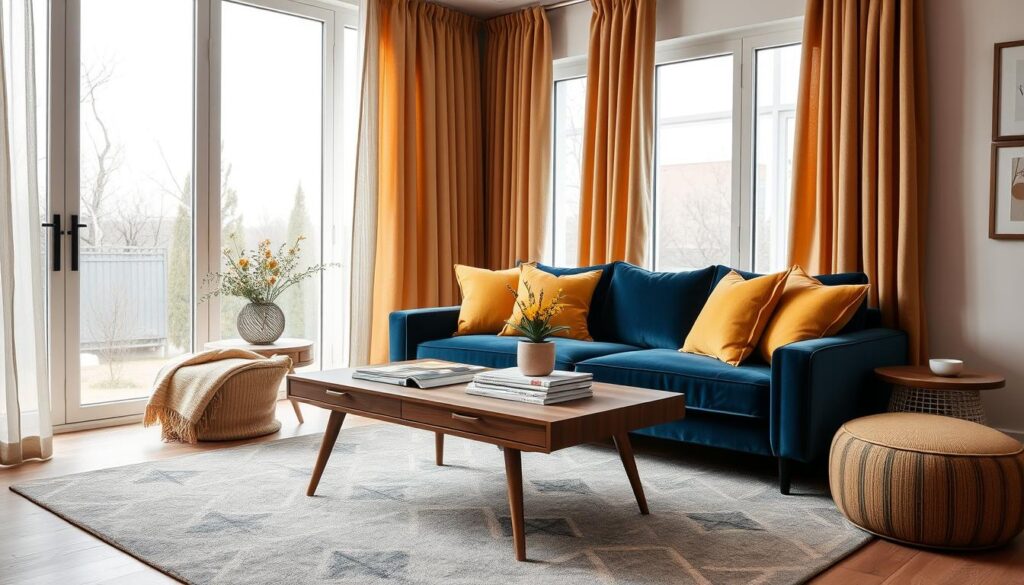
Choosing the Right Fabrics
The fabric you choose greatly affects a room’s feel. Natural fibers like cotton, linen, and silk are popular for their beauty and durability. Think about texture, color, and pattern to match your design.
Cotton works well for upholstery and curtains, giving a cozy feel. Linen makes rooms feel light and airy. Silk adds luxury. Knowing each fabric’s traits helps you make better choices.
Mixing and Matching Patterns
Mixing patterns adds complexity and interest. The trick is to balance them without overwhelming the space. Start with a main pattern, then add one or two that match it well. Think about scale, color, and texture for harmony.
| Pattern Type | Scale | Color |
|---|---|---|
| Stripes | Large | Neutral |
| Floral | Medium | Pastel |
| Geometric | Small | Bold |
Layering Textures for Depth
Layering textures adds depth to rooms. Mix smooth surfaces like glass or metal with rough ones like woven baskets or chunky knits. This contrast makes spaces more interesting and dynamic.
For example, a sleek leather sofa with a chunky throw and a woven rug creates a cozy yet stylish vibe. The goal is to find the right mix of textures for your space.
By carefully choosing textiles, patterns, and textures, you can make your home inviting. Aim for a balance that shows your style and enhances your space’s look.
Lighting Your New Home
Lighting is key in interior design, making our luxury home interiors look better. It lights up our spaces and adds to the feel of the room. It also highlights the best parts of our homes.
Types of Lighting Fixtures
There are many lighting fixtures for different looks in our homes. These include:
- Ambient lighting, which lights up the whole room
- Task lighting, for things like reading or cooking
- Accent lighting, to focus on certain areas or features
Using these lights together makes our spaces look better and work better.
Strategies for Layered Lighting
Layered lighting means using different lights to make a space look good and work well. Here’s how to do it:
- Begin with ambient lighting to set the mood
- Add task lighting for specific tasks
- Use accent lighting to highlight special features
This way, we can change the lighting to fit different times and activities. It makes our homes more flexible and welcoming.
Importance of Natural Light
Natural light is vital in interior design. It cuts down on the need for artificial lights and boosts our mood and health. Using mirrors, sheer curtains, and light colors can make our spaces feel bigger and more open.
By mixing natural and artificial lights, we can create a bright and welcoming space. This shows off our stylish home furnishings and improves our living experience.
Adding Decorative Elements
As we finish our new home’s interior design, it’s time for the final touches. Decorative elements add warmth, character, and personality to our spaces. We’ll look at choosing art and accessories, styling shelves and tables, and adding personal touches.
Choosing Art and Accessories
Choosing the right art and accessories is key to adding a personal touch. We should pick pieces that show our style and fit our home’s look. A big piece of art can be a room’s centerpiece, while accessories like vases add interest.
Tips for Styling Shelves and Tables
Styling shelves and tables is an art that needs balance and creativity. Mix objects of different heights, textures, and colors for a good look. For example, books and vases together can look great. Make sure to leave space between items to avoid clutter.
Incorporating Personal Touches
Adding personal touches makes our home truly ours. This can include family photos, heirlooms, or mementos. Displaying these items thoughtfully makes our home beautiful and welcoming.
Creating Functional Spaces
Functional spaces are key to a well-designed home. They make the home both useful and beautiful. When designing our new homes, we must think about how each space will be used.
In new home interior design, it’s smart to make spaces that can do more than one thing. This way, we use space better and make our homes more versatile.
Designing Multi-Purpose Areas
Multi-purpose areas are great for modern homes with little space. For example, a living room can also be a home office or a guest room.
- Choose furniture that can do more than one thing, like a storage ottoman or a murphy bed.
- Put in elements that can be moved or changed easily.
- Think about the room’s flow and make sure there’s enough room to move around.
Optimizing Small Spaces
Small spaces need careful planning and creativity. Here are some tips to make the most of your small areas:
| Strategy | Description | Benefit |
|---|---|---|
| Use Vertical Space | Install shelves or storage units that go up to the ceiling. | Maximizes storage without cluttering the floor. |
| Select Multi-Functional Furniture | Choose furniture pieces that serve more than one purpose. | Reduces clutter and enhances functionality. |
| Minimize Clutter | Keep surfaces clear and tidy. | Creates a sense of openness and calm. |
Creating Cozy Nooks
Cozy nooks are perfect for relaxing. They can be a great addition to your home. To make a cozy nook, consider the following:
- Find a quiet, comfy spot with good lighting.
- Use plush furniture and soft textiles for a warm feel.
- Add personal touches, like favorite books or decorative items.
By adding these elements, you can make a modern home decor that’s both functional and beautiful.
Sustainability in Interior Design
Sustainability in interior design is more than being eco-friendly. It’s about making a better future. As we learn more, using sustainable practices is key in modern interior design.
Eco-Friendly Materials
Using eco-friendly materials is a big part of sustainable design. These materials are made and sourced to harm the environment less. Examples include reclaimed wood, bamboo, and paints with low VOCs.
By picking these materials, we can lessen our impact on the environment. This makes our decorating ideas better for the planet.
Benefits of Eco-Friendly Materials:
- Less harm to the environment
- Better air inside
- Unique looks
Energy-Efficient Lighting Options
Lighting is vital in design, and choosing energy-saving options is key. LED bulbs use much less energy and last longer than old bulbs. Smart lighting systems also save energy by adjusting based on when people are around and daylight.
“The future of lighting is not just about energy efficiency; it’s about creating a smarter, more responsive environment.” –
Sustainable Furniture Choices
Furniture is another area where we can make a big difference. Look for pieces made from sustainable materials like FSC-certified wood. Furniture designed for recycling or reuse is also great.
Choosing furniture that’s good for the planet adds a special story to your design. Think about a product’s whole life, from making to throwing away, and pick items that fit your green goals.
Finalizing Your New Home Interior
As we near the end of your new home interior design project, it’s key to check your design choices. Make sure they match your dream for a beautiful and useful space. Drawing inspiration from home renovation, you can now see your dream home come to life.
Reviewing Design Decisions
Take a step back and look at your home’s overall look and function. Think about how each part, from colors to furniture, adds to the feel of your home.
Making Final Adjustments
Before you move in, make any last-minute changes to your design. This is the time to perfect the details, making sure your home fits your taste perfectly.
Planning for the Future
As you finish your new home interior, think about how your needs might change. Plan for flexible design elements that will grow with you, keeping your home a cozy haven for years.
